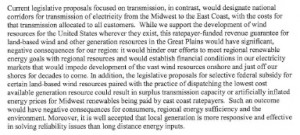Eastern Governors stand up against Transmission!!!
May 6th, 2009
Yeaaaaaaaaaaaa! One for the home team!!!!
First it was NYISO and ISO-New England:
Then it was New York’s Deputy Secretary of Energy testifying before Senate Energy Committee:
And now the Governors from the Northeast and Mid-Atlantic states have stood up against the insane Midwest transmission plans — transmission plans like CapX 2020, JCSP/MTEP, Green Power Express, and the unnamed group announced on April 3rd, starting in North Dakota, banding southern Minnesota, and shooting out into Wisconsin.
Here’s their letter:
It’s blurry, so click the letter and read the whole thing. An eye opener for the Midwest, those who don’t recognize that there’s a big world out there and it’s not all about Midwest wind. Folks, you have a marketing problem, your target market says NO! What about NO can’t you understand?
The Economist weighs in, now it’s YOUR turn!
May 4th, 2009
I’d wondered why “The Economist” had shown up in my blog stats, and now I know. But from the viewpoint of this article, it’s clear they didn’t do more than scratch the surface of transmission in the Midwest. This is “party line” all the way — I hope they’ll now take the time to read NYISO and ISO-NE’s letter of withdrawal from publication of JCSP!
YOUR TURN! Let them know what you think and why — the registration is instantaneous and easy, so COMMENT AWAY!
Spreading green electricity: A gust of progress
Apr 30th 2009 | CHICAGO
From The Economist print edition
Contact Tax Omnibus Conference Committee TODAY!
May 1st, 2009
The Tax Omnibus Conference Committee meets later today.
SEND AN EMAIL NOW! Send to Conference Committee members (below) and also rep.jeremy.kalin [at] house.mn and sen.rick.olsen [at] senate.mn
Message: The Omnibus Tax Bill’s 272.0275 is not specific enough to protect local governments. Your constituents’ local governments deserve assured compensation for hosting electric generation plants. Two simple changes:
- “siting” must be “host fee” — use of “siting” changes the intent of the original idea, which is to assure that there is a HOST FEE agreement in place compensating local governments. “Siting” could mean anything or nothing, and is not sufficient.
- “school district(s)” must be added.
Here’s the language to change: Add “school district(s)“ and “siting” must be “host fee” — use of “siting” changes the intent of the original idea, which is to assure that there is a HOST FEE agreement in place compensating local governments. “Siting” could mean anything or nothing, and is not sufficient.
103.6 Sec. 6. [272.0275] PERSONAL PROPERTY USED TO GENERATE
103.7 ELECTRICITY; EXEMPTION.
103.8 Subdivision 1. New plant construction after January 1, 2010. For a new
103.9 generating plant built and placed in service after January 1, 2010, its personal property
103.10 used to generate electric power is exempt if an exemption of generation personal property
103.11 form, with an attached siting host fee agreement, is filed with the Department of Revenue. The
103.12 form must be signed by the utility, and the county and the city or town and school district where the facility is
103.13 proposed to be located.
103.14 Subd. 2. Definition; applicability. For purposes of this section, “personal property”
103.15 means tools, implements, and machinery of the generating plant. The exemption under this
103.16 section does not apply to transformers, transmission lines, distribution lines, or any other
103.17 tools, implements, and machinery that are part of an electric substation, wherever located.
103.18 EFFECTIVE DATE.This section is effective the day following final enactment.
Here are the members:
Bill(s): HF2323/SF2074
Description: Omnibus tax bill.
Conferees and Date of Appointment
House: 4/29/2009
Lenczewski; Marquart; Koenen; Loeffler; Seifert;



